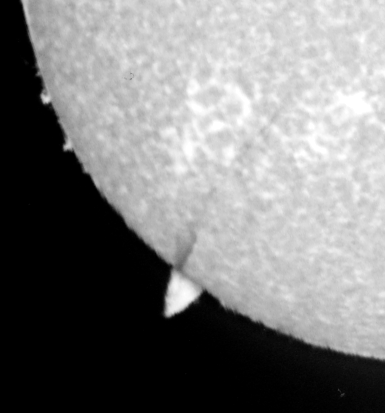The term prominence seems to be used to cover a wide range of phenomena on the sun. Basically a prominence is an area of cooler, denser plasma located above the photosphere i.e. the visible surface of the sun. The term prominence is usually used when such a phenomena is viewed on the limb of the sun, and filament when one is viewed on the solar disc itself. The two words are, however just alternative names for the same phenomenon. Prominences can be split up into a number of categories, depending on their size and position. Basically it seems that there are two main types: quiescent and active. Active ones are located in active regions on the sun and are particularly dynamic, lasting only a matter of hours, usually connected with violent activity on the sun. I have been studying the other main type, quiescent prominences, which are more stable, lasting for weeks or even months. (This does not mean to say they don't erupt violently!) These are the prominences about which I'm writing.
Generally speaking quiescent prominences have temperatures of around 8000K (a hundred times lower than the surroundings) and densities of around a hundred times higher than the surroundings. Size-wise, a typical prominence will be of the order of 100,000km long (that's 1/7th the radius of the sun) and 30,000km high, with a thickness somewhere around 7,000km. The size can vary greatly, but it's form is basically that of a giant flux tube, coming out of the surface of the sun, with hydrogen ions streaming along it. These things are very hard to see with the naked eye (they can be viewed on the solar limb at an eclipse, but are almost impossible to view under normal conditions) and so it is only relatively recently that they have become an active area of scientific research. Interestingly enough, a couple of hundred years ago, some people thought they could be mountains on the sun! In fact, partly due to the traditional difficulty in studying them, and partly to their complicated structure, prominences have always been one of the hardest aspects of solar physics to explain. There are many different theories on their formation and eventual eruption, and I do not want to advocate any particular one of them here. It seems to be generally accepted that a structure of this sort has to be supported in some way by an underlying magnetic field. Prominences are observed to run along the polarity inversion line of areas of magnetic field in the sun, and it would appear that the magnetic field stops the denser material from falling back towards the solar surface. A prominent theory at the moment (no pun intended!) is that filaments form where there is magnetic flux cancellation i.e. areas of positive and negative polarity come together and cancel out. I have been looking for this in my studies, and you can see on the page itself that I have tried to track the formation of the filament, and compare it to the magnetic field around the area. The way I have been viewing prominences has been mostly through images created using hydrogen-alpha emissions (see main page), whereby the filament, as it is seen on the disc, can be seen to appear dark compared to the rest of the sun. At high resolution, a lot of detail can be seen, and people have studied the small fibril-like structures that many filaments have. There has also been a lot of study done on the position and size of filaments, at different times in the solar cycle. I have picked out three very different ones to study on my page. The first is at mid-latitude, and is a very big, stable one. The second comes from an area of much higher magnetic field, and the last is very close to the south pole (a so-called polar crown prominence) and is huge, yet with a much smaller magnetic field around it. They are each very different to look at and study.
Here, below, is a nice example because one can see the prominence sticking out from the edge of the sun, and also follow it along the disc, where it appears dark.
 |